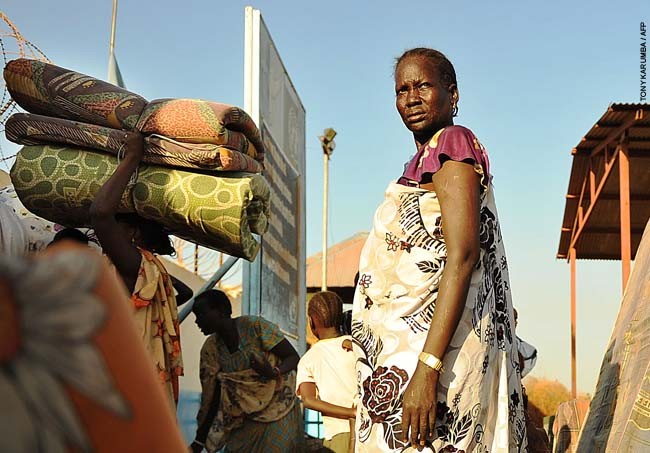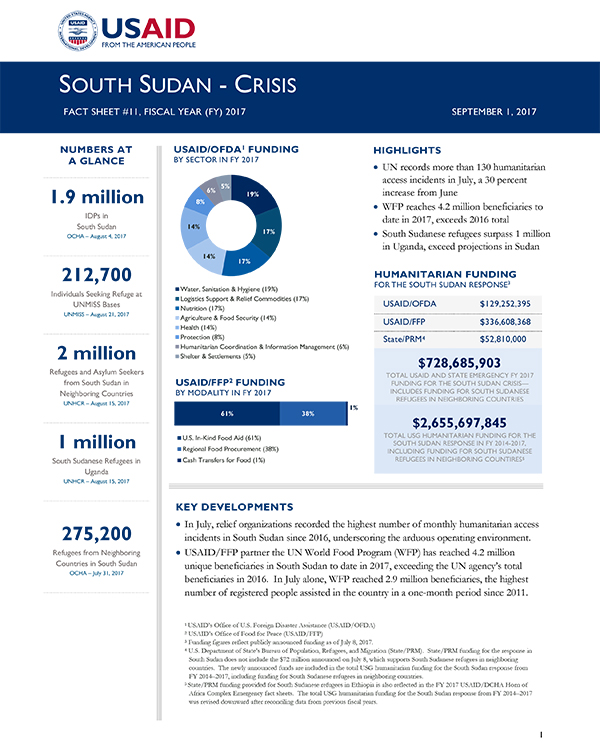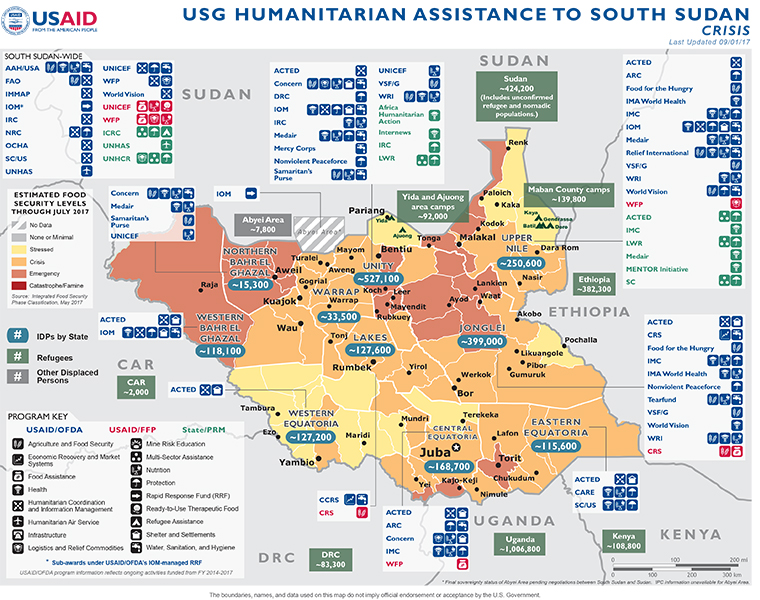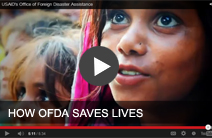- What We Do
- Agriculture and Food Security
- Democracy, Human Rights and Governance
- Economic Growth and Trade
- Education
- Ending Extreme Poverty
- Environment and Global Climate Change
- Gender Equality and Women's Empowerment
- Global Health
- Water and Sanitation
- Working in Crises and Conflict
- Disaster Assistance
- Political Transition Initiatives
- Conflict Mitigation and Prevention
- Countering Violent Extremism
- Disaster Risk Reduction
- Peacebuilding and Reconciliation
- Providing Safe & Secure Environments for Development
- Recovering From Crisis
- Resilience
- Tech Challenge for Atrocity Prevention
- World Humanitarian Day
- U.S. Global Development Lab

Latest South Sudan Fact Sheet
South Sudan Crisis Fact Sheet #11 - 09-01-2017 ![]() (pdf - 348k)
(pdf - 348k)
South Sudan Map - 09-01-2017 ![]() (pdf - 670k)
(pdf - 670k)
view text version [pdf, 348kb]
Key Developments
In July, relief organizations recorded the highest number of monthly humanitarian access incidents in South Sudan since 2016, underscoring the arduous operating environment.
USAID's Office of Food for Peace partner the UN World Food Program (WFP) has reached 4.2 million unique beneficiaries in South Sudan to date in 2017, exceeding the UN agency’s total beneficiaries in 2016. In July alone, WFP reached 2.9 million beneficiaries, the highest number of registered people assisted in the country in a one-month period since 2011.
HUMANITARIAN FUNDING FOR THE SOUTH SUDAN RESPONSE
|
USAID/OFDA |
$129,252,395 |
|
USAID/FFP |
$336,608,368 |
|
State/PRM |
$52,810,000 |
|
Total USAID and State Assistance to South Sudan to date in FY 2017 |
$728,685,903 |
|
Total USAID and State Assistance to South Sudan in FY 2014 -2017 (includes funding for South Sudanese refugees in neighboring countries) |
$2,655,697,845 |
*These figures are current as of September 1, 2017
Background
Since gaining independence from Sudan on July 9, 2011, South Sudan has confronted a number of humanitarian challenges, including population movements and returnee integration. Ongoing conflict in Sudan’s Two Areas of Blue Nile and Southern Kordofan continues to result in refugee flows into South Sudan, straining scarce resources. In addition, many of the people displaced by violence in 2011 from areas north of the River Kiir in the disputed Abyei Area continue to reside in South Sudan. In the two and a half years since people of South Sudanese origin began returning from Sudan on a large scale directly before and after independence, vulnerable communities in South Sudan have struggled to accommodate more than 700,000 new arrivals, many of whom are rebuilding lives and livelihoods with few resources from which to draw. Inter-communal violence and general insecurity also persist in several parts of the country, particularly in Jonglei State, where fighting has led to significant displacement and deteriorating humanitarian conditions.
Lingering effects from more than 20 years of north-south conflict, poverty, and continued tension with Sudan, which led to a cessation of oil exports in 2012 that damaged South Sudan’s economy, compound the humanitarian situation. Confronting deteriorating economic conditions, populations are less able to cope with shocks and increasingly rely on the humanitarian community for basic food and non-food assistance. However, insecurity, bureaucratic harassment of relief organizations, logistical challenges, and Government of the Republic of South Sudan-imposed restrictions constrain humanitarian activities across the country, hindering the delivery of critical assistance to populations in need.
How You Can Help
The best way to help those affected by disasters is to make a cash donation to reputable relief and charitable organizations working in the disaster zone.
For more information, contact the Center for International Disaster Information at ww.cidi.org or 202-821-1999.










Comment
Make a general inquiry or suggest an improvement.